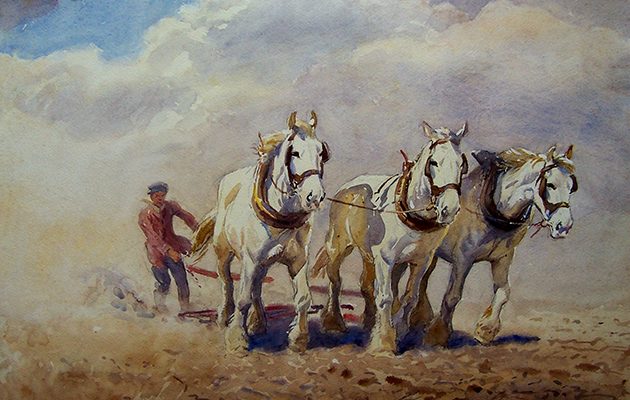The art of the Soper family provided a backdrop to our childhoods. Joy Baker tells Janet Menzies why she has fought to save the collection
The art of the Soper family formed the backdrop of our childhoods. Joy Baker tells Janet Menzies how she is inspiring a whole new generation with the collection, by keeping it together and opening a gallery and education centre.
For more sporting artists, Owen Williams is inspired by watching wildlife at a time that belongs to nature rather than humans. And for Juliet Cursham, travel was the best form of training.
THE SOPER FAMILY
The most interesting feature of the assembly hall at my urban primary school was a poster of a horse ploughing a field, surrounded by gulls dipping down out of a blue and clouded sky. “We plough the fields and scatter…” was the caption. I had never seen a ploughed field and had only the haziest idea of what scattering might entail, but I was so captivated by the picture that I made up my mind to work just as hard as it took to get where I could plough, and possibly even scatter.

Red squirrel by Eileen Soper.
A lifetime later, I have discovered that the iconic image was created by artist George Soper, the foremost painter of working horses around the period of the First World War, a time when Britain was still dependent on horsepower. Soper, and then his two daughters, Eva and Eileen, produced a massive body of work depicting the nature and wildlife of the countryside in the early and mid 20th century. Eileen’s work is even more inspirational than her father’s, as she illustrated Enid Blyton’s Famous Five stories, along with many other educational and natural history works. Between them, the Soper family influenced a whole generation, inspiring people to love and respect the rural world and to aspire to be part of it. Yet few of us have any idea how this potent and now nostalgic work came about.
Joy Baker has made it her mission to create The Soper Heritage Art Gallery and Education Centre to inspire a whole new generation. She explains: “So many people were affected by their work. One of our sponsors, Robin Bailey, chairman of Sudbury Chamber of Commerce, described exactly the same experience as you. It took him straight back to the classroom and Eileen’s illustration of fish under water, and how he had wanted to discover all about it.”
A STORY THAT MUST BE TOLD
Baker and her late husband, John, fell in love with the art of George Soper and his daughters back in the 1990s when the work began to be sold after the hospitalisation and death of Soper’s daughters. Baker says: “When John first saw the working horse paintings he felt it was tragic that the collection was being broken up. Their art and social history, the collaboration between horses and man that had made England – and was so important in the First World War – the work that they did and the relationship over all these years, is a story that must be told. So we bought a few paintings. And then we discovered Eileen and Eva and wanted to buy their work as well, but we didn’t know what to do about money. So John said, ‘Let’s take out a mortgage.’ We both felt it was imperative that as much of the family’s work as possible should be kept together. When my husband died of mesothelioma contracted during his war service, this became my mission. A major sale of the Sopers’ work came up and I had to do my best to establish the collection. But I had no money. So I asked the dealer if he would take a post-dated cheque and he said yes. Even so, I had no idea how I was going to manage, but I was determined.”

A kingfisher by Eva Soper for Royal Worcester.
Finally, Baker has almost arrived at her goal. “We have found a 17th-century barn just outside Lavenham, which is the perfect site for the gallery and education centre. So we have taken the plunge and put down a deposit on the site – but by 20 November we have to find the money to complete the purchase. For the past 25 years all I have done is concentrate on this and it has been so worthwhile. Now the work has got to be seen by the public. I know how you can change a child’s life by opening their eyes. Today especially, with so many young people in such troubled situations, it is vital to be able to inspire them.”
Could a Facebook-generation child be captivated by the Sopers’ imagery in the way that we were? Looking back, we may cast a rosy glow of nostalgia and idealisation over illustrations of children on adventures, or badgers emerging from their setts after hibernation. In fact, the Sopers’ work is earthy – both literally and metaphorically. “Their art is true,” says Baker. “It is representational art. It is totally true. There is no self. And today is about self, and it is not authentic depiction.”

Enid Blyton’s Five on a Treasure Island, illustrated by Eileen Soper.
When I was first exposed, almost subliminally, to the work of the Sopers, I was every bit as far from a horse or a badger as children are today. I think any child, of any time, wants the chance to hug a horse or be more badger.
To donate urgently needed funds or find out more about the project, go to: www.thesopercollection.org





